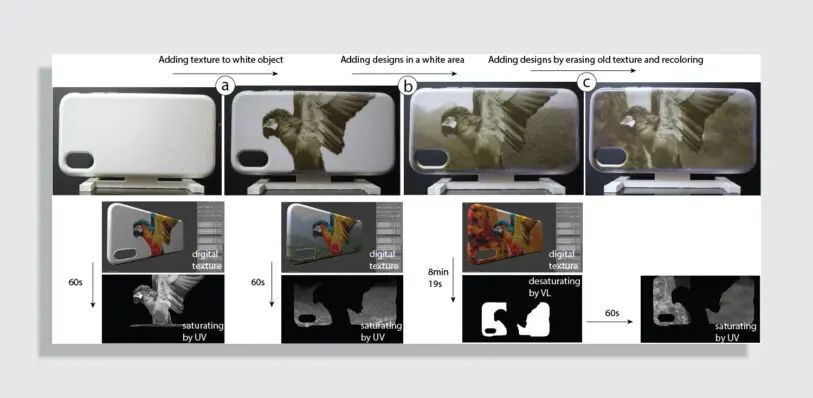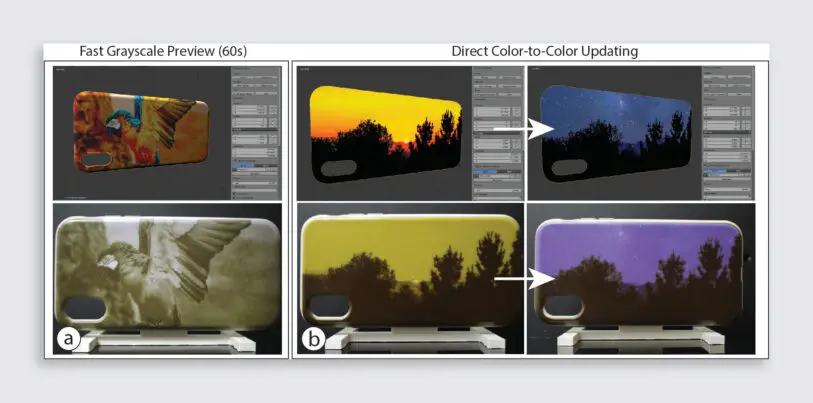Color-changing Hypercolor shirts were all the rage in the ’90s. But for the most part, when something is made, its color is set. That’s true for everything from iPhone cases to dresses to cars.
New research out of the Massachusetts Institute of Technology could change the way we look at color forever—not as a permanent finish for a product, but as a temporary identity programmed into it. MIT has developed a new light-sensitive paint that makes it cheap, easy, and fast to update the color and pattern on just about anything. All you need is a special light box and a few minutes of time.
[Image: HCI Engineering/MIT/CSAIL]Dubbed ChromoUpdate, the basic idea is this: MIT’s paint is applied to a product. The paint itself is usually clear. But when exposed to particular frequencies of light, it reveals hidden pigments.
When blasted with ultraviolet light, the paint turns black (and yes, that’s the same kind of invisible light you’ve been hearing about for blasting the SARS-CoV-2 virus to purify surfaces and air). Within just 60 seconds, ultraviolet light can draw an intricate grayscale pattern onto the paint’s surface—anything from printed words to mountainous landscapes—in high-resolution fidelity. Then the design stays around, even after you remove it from the UV light.

As MIT postdoc and the project’s lead researcher Michael Wessely explains, there are all sorts of benefits to a color-changing paint. He suggests that designers, in particular, would be able to test products quickly, swapping out colors and patterns in minutes.
In a broader sense, Wessely imagines that quickly projecting what is essentially data onto everyday objects could make smart homes even smarter, without the use of more screens in your house. His team proved they could print text and images right onto a coffee mug. Every day, he suggests, you could print your schedule onto your mug, and reference your own cup of coffee to know when your next meeting is going to be.

While the possibilities for products are intriguing, the work has a long way to go before it takes off in consumer products. UV light can be dangerous when it comes into contact with human skin, which is why MIT’s research relies on using a special UV light box to contain its projector. Basically, everyone would have to own a small, safe lighting rig at home. For professional contexts, that’s not a challenge. But it would be pricey and bulky for everyday people, and it’s hard to imagine many investing in this product in hopes of using it on other products.
[Image: HCI Engineering/MIT/CSAIL]The other issue is that the designs fade over time, because UV light is all around us. Wessely suggests the paint can hold its contrast and colors for about two days in an office context, where you are probably far from sunlight (and its UV rays). Carrying something outside would shorten the time span significantly. That length of time isn’t necessarily a big problem if you can easily reblast your iPhone or coffee mug with a fresh design. But it’s hard to imagine society adopting that sort of habit, isn’t it?
The more promising angle is embedding the technology into fashion, which Wessely’s team is working on now. They’re developing fibers which could be woven into anything from shirts to shoes, featuring the same light-sensitive dyes. Wessely believes that they can actually integrate teeny-tiny lights into clothing to activate designs and colors right on your person.
In that context, where the light is very close to the dye, the color-changing process is more efficient. “We can likely make the color change instantaneous, even below one second,” he says. Meanwhile, Wessely says that a UV-absorbing coating can be applied. Imagine a T-shirt that could have a new slogan on it every hour, or a purse that could color-change to match any outfit. Following microtrends in fashion wouldn’t necessarily require you to buy anything new, which could democratize style into something that moves at the speed and accessibility of social media.
To get there, the team will have to create the fabric. They would then need to create software that can accommodate printing patterns onto a textile that stretches, moves, and contours across someone’s body. It’s hard, in part because this field of inquiry is so young. “Usually you have 10 years of research behind something,” Wessely says. “[But] we just started exploring this space because it’s so new.”
Recognize your brand’s excellence by applying to this year’s Brands That Matter Awards before the early-rate deadline, May 3.